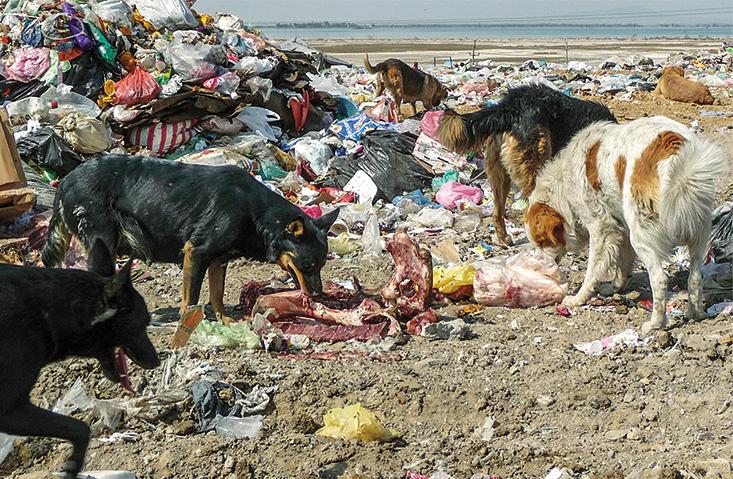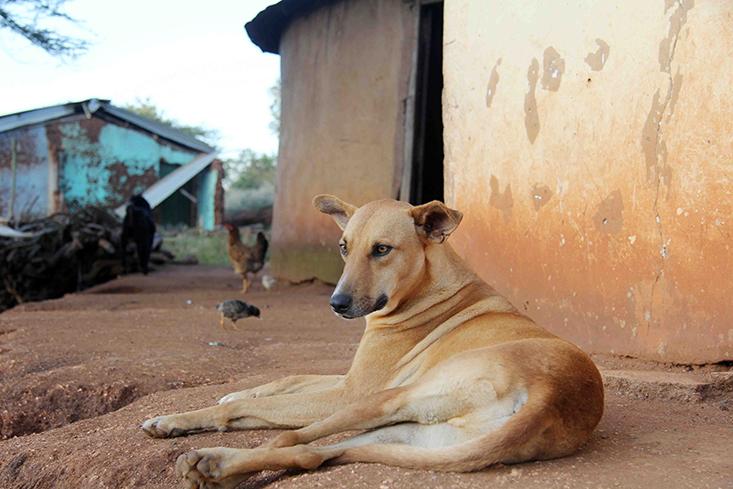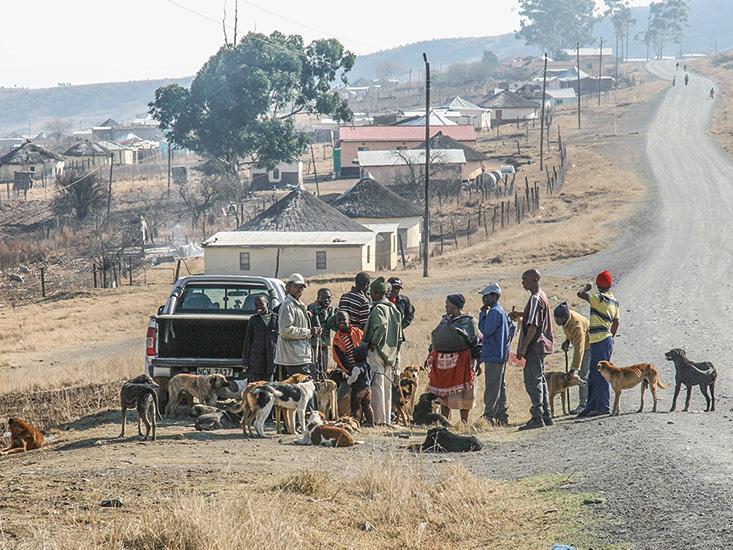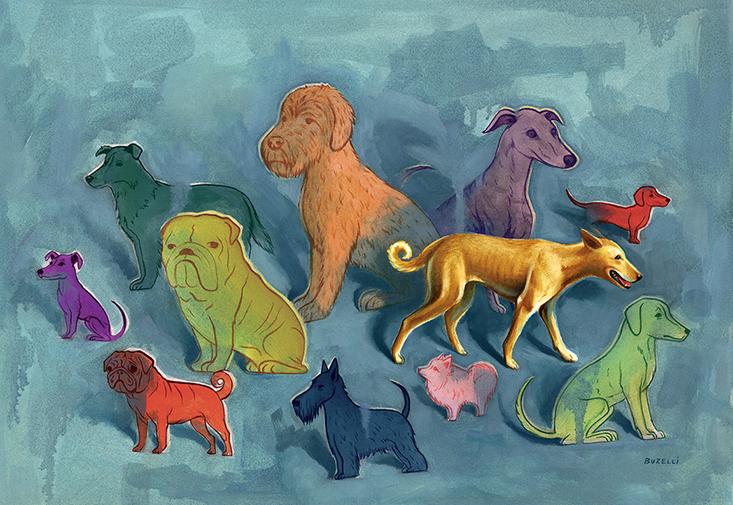What is a dog? Many people often think of dogs as kennel club creations. The purebred dog is man’s best friend, not the street dog. Man’s best friends live ubiquitously in the United States, Europe, and other developed countries and, in these countries, are by and large household pets. Man’s best friends only live in areas where people have easy access to vaccines against rabies and distemper. They are the results of certain levels of commercial appeal involving pet stores, breeders, dog food companies, veterinary medicine, magazines, and books.
But could it be that breeds represented as working, hunting, or pet groups don’t represent real dogs? Could it be that the so-called stray dogs, street dogs, neighborhood dogs, village dogs, and even feral dogs of the world are the real, naturally evolved, self-selected dogs?

When watching the dogs in the Mexico City dump, a number of our students would say, “These dogs are different from real dogs—these are mongrels.” The implication is that the kennel club breeds are the ancestors of the village dogs. People seem to believe that if a dog doesn’t look like one of the kennel club recognized breeds then it must be a hybrid or mongrel. People think if you let all the pure breeds go and they interbreed for a few generations, the resulting population of dogs would look like the Mexico City dump dogs.
However, this cannot be true. For instance, dogs on the East African Island of Pemba all look the same, and they have never been anywhere near any breed of dog. Breeds of dogs are a result of what Darwin labeled artificial selection, which he contrasted with natural selection. He was impressed with, even in awe of, people who created breeds of pigeons or dogs or the myriad of farmyard species. Darwinian artificial selection happens when humans select for a particular trait by sexually isolating a male and a female from the general population. Modern humans with their chain-link fences and wire cages find that isolation fairly easy to do, which is why most of the greatest number of breeds of dogs or breeds of anything are relatively recent. Thus, artificial selection enabled the purposeful creation of most of our present breeds of dogs.
Could it be that breeds represented as working, hunting, or pet groups don’t represent real dogs?
Numbering only about 15 percent of the world’s population of dogs, the purebreds, if left to mingle with a free-ranging population, are not going to have any effect on the genetic structure of the world population of dogs. If you released those 150 million purebred dogs into the wild all at once, they would not survive for very long. Why? They aren’t adapted to any ecological niche, and their numbers would be rapidly swamped by the 850 million village or street dogs, either by not finding adequate food or by crossbreeding with the wild dogs.
Our beautiful village dogs are neither the result of artificial selection nor the result of mongrelization of stray pet dogs. The similarity in size and overall design of all the street dogs and village dogs should give you a clue—a clue about natural selection.

Of the billion dogs in the world, three-quarters of them look as much alike as do the individuals of any other species. A few years ago we asked a Navajo shepherd what a Navajo sheepdog looked like. He said, “A Navajo sheepdog is not too big and not too small.” To us the Navajo sheepdogs were identical in size and shape and color variations with the sheepdogs of Sonora and the village dogs in the mountains of Venezuela or the ones we worked with in eastern and South Africa or saw in India and China. That is true of the majority of dogs in the world—they are not too big and they are not too small. One of the most fascinating details about that 75 percent of the dogs in the world that control their own reproductive life is: They all look similar.
For a biologist, that kind of uniformity implies the process of natural selection. Their size and shape (and even color) indicate an adaptation to a niche. The village dog is not a blending of purebreds that was created by artificial selection. The village dog is the animal that evolved on its own, with no reproductive control by humans, and is adapted to the niche in which it makes its living. The message is, those look-a-like dogs have evolved right there in their niche and are uniquely adapted to this niche. They are not escapees from irresponsible dog owners. They are a natural species that lives close to humans, finds its own food, and mates perfectly well without human control.
Our task here is to demonstrate that the dog is a species of mammal that is adapted to its own particular environments. The dog is a shape that has evolved to a new niche that was created when people switched from hunting and gathering to growing grain. The waste products of that activity created a food supply that supports village dogs. Were there dogs before the age of agriculture? Probably not, but if there were, they had adapted to a different niche.
When one shape evolves into another shape, the Darwinian assumption is that the new shape is an adaptation to a new niche. A new niche means a new source of food and nesting places and a good location to raise pups, where the dangers aren’t overwhelming.
Darwin pointed out that more animals are born than there is food to feed them. In other words, for most animals, the cost of behaving (searching for, chasing, and killing prey) is going to be greater than the benefit of behaving (calories in the prey). For most animals the costs outweigh the benefits, and therefore most animals are starving and won’t reproduce—no pups. Darwin theorized that a few individuals behave so efficiently (they are better fit, or adapted), that the benefit will be greater than the cost. Those animals will survive and reproduce.
Let us run this argument again. The dog evolved, meaning it changed shape from whatever the ancestor looked like. We are assuming that happened because the new shape was an adaptation to a new niche. Adapting to a new niche means the new shape was more efficient in that new niche than the old shape.
Walking or chasing is not the only cost. Add in an energy cost in building the organism from a single-celled egg to the reproductive adult; this is called the design cost. How much does it cost (in calories) to build the dog? It costs much more to build a 100-pound wolf than it does to build a 30-pound dog.
We begin to realize how well designed the dog is for its niche.
Just for ease of thinking about it, assume that the design of the wolf requires 2,500 calories a day to grow up. It needs less at the beginning and more at the end of the growth period. The average wolf needs 2,500 calories per day until it is nearly 2 years old (365 days × 2 years × 2,500 calories) = 1,825,000 calories. It takes close to 2 million calories to grow a wolf pup to the size and shape at which it could efficiently kill its first caribou (not counting the costs to the parents).
The design of the dog, in contrast, requires 1,000 calories per day (less when a tiny pup) for many fewer days to become an efficient acquirer of food than does a wolf pup. A young dog can begin obtaining its own food as early as 10 weeks of age. In the Mexico City dump, pups start scavenging food shortly after they are weaned. We figure 1,000 calories × 70 days = 70,000 calories. The dog needs 3.5 percent of the calories a wolf needs to get to the point of collecting their own food. Think about that. If I drop a 70-day-old wolf in the middle of a caribou herd, what are its chances of surviving? Just about zero. If I drop a 7-day-old dog pup in the Mexico City dump, what are its chances of finding enough to live on? Not great—but a lot better than the wolf pup among large robust ruminants.

The wolf pup becomes sexually active in its second year, taking 2 million calories to get there. The dog can become pregnant at seven months (after consuming 210,000 calories) or 10 percent of what wolves require just to get bred for the first time. Getting the dog to reproductive age costs a small fraction, in terms of calories, of what it takes to get the wolf to that first litter of pups.
In other words, the design of the dog means it is cheaper to build than that of the wolf. Why do we compare the design cost of the dog with that of the wolf and not with the coyote or jackal, which are closer in size to the village dog? The enormous differences in the costs of wolves compared to dogs exaggerate the discussion in order to emphasize the way a behavioral ecologist thinks about the fitness of animals for their niche.
But even if we had used the 25-pound coyote or jackal to illustrate our point, we still would find dogs to be less expensive in comparison by the time they reach hunting and reproductive ages. In part, this is because if the adult shape is the perfectly adapted shape for hunting, then anything different from that shape is not as good and will be out-competed, and therefore the juvenile is always at a disadvantage simply because it doesn’t have the adaptive shape until it grows up. Consequently, the design of coyotes and jackals includes help in calories from mom, pop, and often an older sibling, which is not true of the dogs.
Another big calorific cost for any species is finding food. In fact, the evolved shape of any species is almost always a signal about how it feeds and what it feeds on. The size of the animal, the shape of its mouth, and the shape and number of teeth are all clues for how it gets its food. Let us look again at why the 850 million village dogs all look alike, by answering, “What is the cost of behaving compared to the returns on that investment of energy?”
For a wolf or a dog, the cost of the transportation to food is measured in calories, plus the cost of acquiring that food (the killing cost for the wolf) measured in calories, and the repair cost measured in calories, divided into the benefit of the food acquired measured in calories, and the result has to be greater than one.
Let’s compare the foraging behavior of the village dogs with that of the wild canids. Every day, the dogs sit in the Mexico City dump and wait for the garbage trucks to arrive. Their transportation cost to food in calories is about zero. Their acquisition cost is about zero. Since the food is dead on arrival, killing cost is about zero, and any repair cost minimal. In our wolf/moose story, for example, the moose doesn’t exactly want to be killed and eaten and defends itself, whereas the discarded lamb chop at the dump doesn’t care.

What about bottlenecks in the dump if food becomes short for one day? About zero. In other dog studies done in South Africa by Daniel Stewart, the dogs are only eating once every other day or every third day. And, of course, that is true of wolves, which only get a bellyful once every three or more days.
What about seasonal fluctuation? About zero. People access a similar amount of food every day. They create a similar amount of waste from that food supply every day. The bottom line is that the scavenging dogs receive access to a food supply that varies little, every day of every month of every year. The garbage collectors have full-time jobs and work steadily every month of the year.
The reason dogs make good pets is this innate behavior of finding somewhere to sit and wait for food to arrive.
A dump dog has few foraging costs compared with its wild relatives, which must put a huge effort into obtaining food. When one compares the cost with the benefit, dump dogs are way ahead. Getting calories is mostly easier for them.
The reason dogs make good pets is in large part because they have this innate behavior of finding somewhere to sit and wait for food to arrive, which is exactly what our pet dogs do. Their niche is scavenging food from humans. They are like ravens and foxes that scavenge food from wolves or humans. Where is that dog food supply? Look for humans, and there it is. Why are dogs nice to people? They are the source of food. Dogs find some food source that arrives daily and they sit there and wait.
One question we might ask, in order to find any foraging difference between dog and wolf, is whether wolves could scavenge the Mexico City dump as well as dogs do. All of a sudden when we ask the question that way, we begin to realize how well designed the dog is for its niche. Remember the design costs. It takes 1,000 calories a day to maintain a dog, and it takes 2,500 calories for a wolf just to hang around acting doglike.
How about jackals and coyotes that are about the same size as our village dogs? Why aren’t they in the dump, reducing their transportation, acquisition, and repair costs? Interestingly enough, wolves, coyotes, dingoes, and jackals quite often scavenge in dumps, but only if the dumps are empty of people.
Imagine if two purebred dogs, a male and female St. Bernard, strayed into the Mexico City dump. Would they live happily ever after, rearing big litters of St. Bernards every six months? Of course not. The idea of dog breeds thriving among that enormous dump-dog population goes against the principles of biology. The same selective pressures that influenced the shape and behavior of the village dogs would apply to the purebreds, which would have to compete with the much better adapted village dogs for resources and space. Although St. Bernards could pass their genes onto the wider population of dogs, their successful offspring would look less like St. Bernards and more like village dogs.
This points us to our original question: What is a dog? It can’t be the purebred, artificially selected by humans and constituting a small fraction of the canine population. Rather it’s the populous village dog. In fact, we have good reason to think of them as the true purebred. They are not mongrels or stray kennel pups let loose on a village, but a species that over time has become finely, beautifully adapted to its niche.
Raymond Coppinger is professor emeritus of biology at Hampshire College. Lorna Coppinger is a biologist and science writer. Their books together include Dogs: A New Understanding of Canine Origin, Behavior, and Evolution, also published by the University of Chicago Press.
Adapted with permission from What Is a Dog?, by Raymond Coppinger and Lorna Coppinger, published by the University of Chicago Press. © 2016 by The University of Chicago. All rights reserved.



























